
Canarium is a genus of about 100 species of tropical and subtropical trees, in the family Burseraceae. They grow naturally across tropical Africa, south and southeast Asia, Indochina, Malesia, Australia and western Pacific Islands; including from southern Nigeria east to Madagascar, Mauritius, Sri Lanka and India; from Burma, Malaysia and Thailand through the Malay Peninsula and Vietnam to south China, Taiwan and the Philippines; through Borneo, Indonesia, Timor and New Guinea, through to the Solomon Islands, Vanuatu, New Caledonia, Fiji, Samoa, Tonga and Palau.

Gasteracantha is a genus of orb-weaver spiders first named by Carl Jakob Sundevall in 1833. Species of the genus are known as spiny-backed orb-weavers, spiny orb-weavers, or spiny spiders. The females of most species are brightly colored with six prominent spines on their broad, hardened, shell-like abdomens. The name Gasteracantha is derived from the Greek gaster (γαστήρ), meaning "belly, abdomen", and akantha (άκανθα), meaning "thorn, spine". Spiny-backed orb-weavers are sometimes colloquially called "crab spiders" because of their shape, but they are not closely related to the true crab spiders. Other colloquial names for certain species include thorn spider, star spider, kite spider, or jewel spider.

Drypetes is a plant genus of the family Putranjivaceae, in the order Malpighiales.
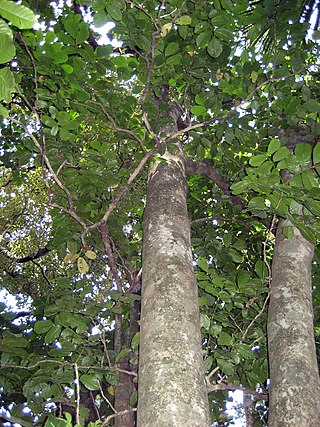
Dysoxylum is a flowering plant genus of trees and shrubs from the mahogany family, Meliaceae.
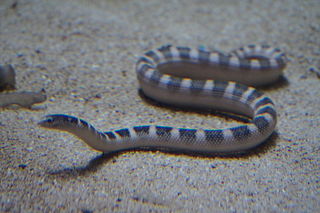
Hydrophis ornatus, commonly known as the ornate reef sea snake, is a species of venomous sea snake in the family Elapidae.
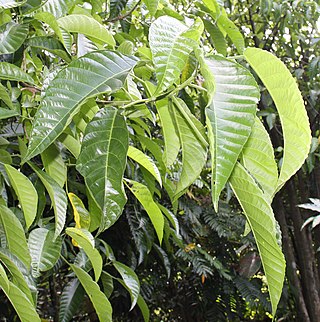
Dendrocnide is a genus of approximately 40 species of plants in the nettle family Urticaceae. They have a wide distribution across North East India, Southeast Asia, Australia and the Pacific Islands. In Australia they are commonly known as stinging trees.

Chionanthus, common name: fringetrees, is a genus of about 150 species of flowering plants in the family Oleaceae.

Actinodaphne is an Asian genus of flowering plants in the laurel family (Lauraceae). It contains approximately 125 species of dioecious evergreen trees and shrubs.

Barringtonia is a genus of flowering plants in the family Lecythidaceae first described as a genus with this name in 1775. It is native to Africa, southern Asia, Australia, and various islands of the Pacific and Indian Oceans. The genus name commemorates Daines Barrington.

Melodinus is a genus of plant in the family Apocynaceae, first described as a genus in 1776. It is native to Indomalaya, Meganesia and various islands in the western Pacific. A type of monoterpenoid indole alkaloids called melodinines can be isolated from Melodinus plants.
Progonia is a genus of moths of the family Erebidae. The genus was erected by George Hampson in 1896.

Comostola is a genus of moths in the family Geometridae erected by Edward Meyrick in 1888. They are found primarily in Asia and Australia.
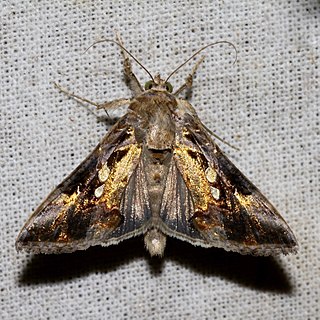
Argyrogramma signata, the green semilooper, is a moth of the family Noctuidae.

Phaleria is flowering plant genus of about 20–25 species in the family Thymelaeaceae.

Chrysoglossum is a genus of flowering plants from the orchid family, Orchidaceae. Its 4 species are native to China, the Indian Subcontinent, southeast Asia, New Guinea and some islands of the western Pacific.
- Chrysoglossum assamicumHook.f.. - Guangxi, Tibet, Assam, Thailand, Vietnam
- Chrysoglossum ensigerumW.Burgh & de Vogel - Sumatra
- Chrysoglossum ornatumBlume - India, Nepal, Assam, Bhutan, Sri Lanka, Cambodia, Thailand, Vietnam, Malaysia, Java, Borneo, Sulawesi, Sumatra, Philippines, New Guinea, Fiji, New Caledonia, Samoa, Vanuatu, China
- Chrysoglossum reticulatumCarr - Sabah, Sarawak
Erythrodes is a genus of flowering plants from the orchid family, Orchidaceae. It contains 26 currently recognised species, native to Southeast Asia, China, the Indian Subcontinent, New Guinea, and some islands of the Pacific.
- Erythrodes amboinensis(J.J.Sm.) J.J.Sm. - Ambon
- Erythrodes bicalcarata(R.S.Rogers & C.T.White) W.Kittr. - New Guinea
- Erythrodes bicarinataSchltr. - New Guinea, Vanuatu
- Erythrodes blumei(Lindl.) Schltr. in K.M.Schumann & C.A.G.Lauterbach - from Assam east to Taiwan, south to Java
- Erythrodes boettcheriAmes - Luzon
- Erythrodes celebensisP.O'Byrne - Sulawesi
- Erythrodes forcipataSchltr. - New Guinea
- Erythrodes glandulosa(Lindl.) Ames - Borneo
- Erythrodes glaucescensSchltr. - New Guinea
- Erythrodes hirsuta(Griff.) Ormerod in G.Seidenfaden - Hainan, Assam, Bhutan, Myanmar, Thailand, Vietnam
- Erythrodes humilis(Blume) J.J.Sm. - Java, Sumatra, peninsular Malaysia
- Erythrodes johorensis(P.O'Byrne) Ormerod - peninsular Malaysia
- Erythrodes latifoliaBlume - Java, Sumatra, peninsular Malaysia
- Erythrodes latilobaOrmerod - Sri Lanka
- Erythrodes oxyglossaSchltr. - Fiji, New Caledonia, Samoa, Tonga, Vanuatu, Wallis & Futuna
- Erythrodes papuanaSchltr. in K.M.Schumann & C.A.G.Lauterbach - New Guinea
- Erythrodes parvulaKores - Fiji, Tonga
- Erythrodes praemorsaSchltr. - New Guinea
- Erythrodes purpurascensSchltr. in K.M.Schumann & C.A.G.Lauterbach - New Guinea, Fiji, Tonga, Samoa
- Erythrodes sepikanaSchltr. - New Guinea
- Erythrodes sutricalcarL.O.Williams - New Guinea
- Erythrodes tetrodontaOrmerod - New Guinea
- Erythrodes torricellensisSchltr. - New Guinea
- Erythrodes trilobaCarr - Sabah
- Erythrodes weberiAmes - Philippines
- Erythrodes wenzeliiAmes - Philippines

Vrydagzynea, commonly called tonsil orchids, is a genus of orchids in the tribe Cranichideae. About forty five species of Vrydagzynea have been formally described. They are native to India, Taiwan, Southeast Asia, Malesia, Melanesia and Polynesia. A single species in Australia is possibly extinct. They have thinly textured, stalked leaves and small, dull-coloured resupinate flowers with the dorsal sepal and petals overlapping to form a hood over the column.
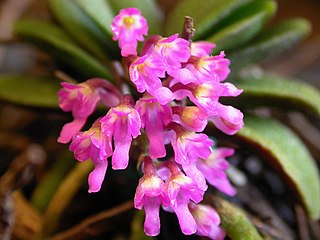
Schoenorchis, commonly known as flea orchids, or 匙唇兰属 in Chinese, is a genus of flowering plants from the orchid family, Orchidaceae. Plants in this genus are small epiphytes with thin roots, thin leafy stems with leaves in two ranks and tiny fragrant, almost tube-shaped flowers with a prominently spurred labellum. There are about twenty five species found from tropical and subtropical Asia to the Western Pacific.

Sciaphila is a genus of mycoheterotrophic plants in the family Triuridaceae. These plants receive nutrition from fungi and neighboring trees and have less need for photosynthesis. It is widespread in tropical and subtropical regions, found in Africa, China, Japan, the Indian Subcontinent, Southeast Asia, Latin America and on various islands Pacific Islands. The most noteworthy feature of the genus is the number of the various flower parts 99.9 percent of Monocots are trimerous, but Sciaphila spp. can have eight or even ten parts in a whorl.


















